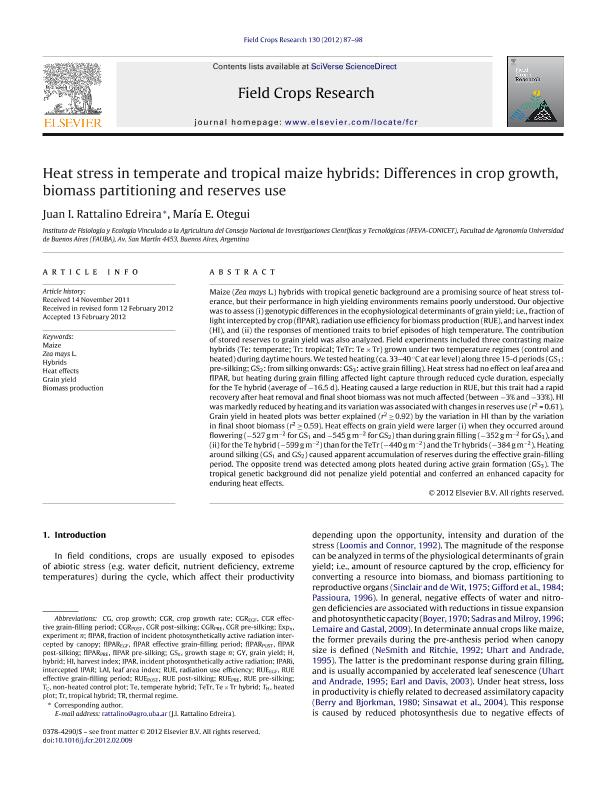Artículo
Heat stress in temperate and tropical maize hybrids: Differences in crop growth, biomass partitioning and reserves use
Fecha de publicación:
03/2012
Editorial:
Elsevier Science
Revista:
Field Crops Research
ISSN:
0378-4290
Idioma:
Inglés
Tipo de recurso:
Artículo publicado
Clasificación temática:
Resumen
Maize (Zea mays L.) hybrids with tropical genetic background are a promising source of heat stress tolerance, but their performance in high yielding environments remains poorly understood. Our objective was to assess (i) genotypic differences in the ecophysiological determinants of grain yield; i.e., fraction of light intercepted by crop (fIPAR), radiation use efficiency for biomass production (RUE), and harvest index (HI), and (ii) the responses of mentioned traits to brief episodes of high temperature. The contribution of stored reserves to grain yield was also analyzed. Field experiments included three contrasting maize hybrids (Te: temperate; Tr: tropical; TeTr: Te×Tr) grown under two temperature regimes (control and heated) during daytime hours. We tested heating (ca. 33-40°C at ear level) along three 15-d periods (GS 1: pre-silking; GS 2: from silking onwards: GS 3: active grain filling). Heat stress had no effect on leaf area and fIPAR, but heating during grain filling affected light capture through reduced cycle duration, especially for the Te hybrid (average of -16.5 d). Heating caused a large reduction in RUE, but this trait had a rapid recovery after heat removal and final shoot biomass was not much affected (between -3% and -33%). HI was markedly reduced by heating and its variation was associated with changes in reserves use (r 2=0.61). Grain yield in heated plots was better explained (r 2≥0.92) by the variation in HI than by the variation in final shoot biomass (r 2≥0.59). Heat effects on grain yield were larger (i) when they occurred around flowering (-527gm -2 for GS 1 and -545gm -2 for GS 2) than during grain filling (-352gm -2 for GS 3), and (ii) for the Te hybrid (-599gm -2) than for the TeTr (-440gm -2) and the Tr hybrids (-384gm -2). Heating around silking (GS 1 and GS 2) caused apparent accumulation of reserves during the effective grain-filling period. The opposite trend was detected among plots heated during active grain formation (GS 3). The tropical genetic background did not penalize yield potential and conferred an enhanced capacity for enduring heat effects. © 2012 Elsevier B.V.
Palabras clave:
Biomass Production
,
Grain Yield
,
Heat Effects
,
Hybrids
,
Maize
,
Zea Mays L.
Archivos asociados
Licencia
Identificadores
Colecciones
Articulos(IFEVA)
Articulos de INST.D/INV.FISIOLOGICAS Y ECO.VINCULADAS A L/AGRIC
Articulos de INST.D/INV.FISIOLOGICAS Y ECO.VINCULADAS A L/AGRIC
Citación
Rattalino Edreira, Juan Ignacio; Otegui, Maria Elena; Heat stress in temperate and tropical maize hybrids: Differences in crop growth, biomass partitioning and reserves use; Elsevier Science; Field Crops Research; 130; 3-2012; 87-98
Compartir
Altmétricas




